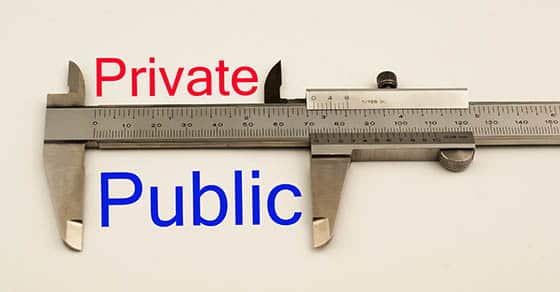Business valuation professionals often use public stock market data to value private businesses — even though there are critical differences between closely held and publicly traded companies. Here’s an overview of how valuators modify their analyses to take advantage of objective, market-based indicators of value.
Recognizing key differences
Public companies differ from private ones in the following five critical ways:
1. Level of oversight, differing goals. The Securities and Exchange Commission requires public companies to file paperwork (such as annual 10-K forms) and comply with its rules and regulations (such as the Sarbanes-Oxley Act). Private businesses are generally exempt from these requirements, freeing them to focus less on earnings per share (a short-term performance metric) and more on long-term or nonfinancial goals. Additionally, private businesses commonly downplay taxable income to minimize taxes, rather than emphasize earnings to satisfy investors.
2. Variations in size and diversification. With greater access to financing, public companies typically offer a broader product mix and serve a wider geographic market. By comparison, private businesses often operate as “pure players” (as opposed to public conglomerates) or serve niche markets. They also possess fewer resources to weather temporary economic downturns or the loss of a major customer.
3. Management. Public investors typically hold management accountable for financial performance and mandate change when performance falls short of expectations. Private company stakeholders, on the other hand, tend to tolerate business owners with nonfinancial priorities, such as employing relatives or pursuing “pet” projects.
4. Marketability. Private business interests tend to be less marketable than those traded on the public markets. Not only do these interests lack an open market to trade shares, but shareholder agreements also may restrict transfers.
5. Reliability of financial data. Perhaps the most significant difference between private and public companies is that private ones lack published stock prices and transparent financial data. This is a key reason that public stocks can provide insight into private company value.
For example, under the guideline public company valuation method, experts use public stock prices to value private business interests. Here, pricing multiples are calculated based on comparable stocks, then the multiples are applied to the subject company’s income stream.
Similarly, public stock returns are used to gauge risk under the capitalization of earnings method. In a nutshell, a valuator factors public stock returns into the subject company’s cost of equity — an important component of the capitalization rate. (The capitalization rate estimates the rate of return required to attract an investor to a particular company.) Higher required returns generally equate with lower value, and vice versa.
Bridging the gap
Valuation professionals use a variety of techniques to bridge the gap between private and public companies, including:
- Adjusting a subject company’s income stream to more closely align it with reporting norms of public comparables,
- Modifying median pricing multiples from a group of comparables to accommodate for differing financial performance between the subject company and the public comparables,
- Building a cost of equity that factors the incremental risk inherent in the subject company’s size or company-specific characteristics, and
- Qualifying valuation discounts to account for the subject business interest’s relative lack of control and/or marketability.
In addition, public market data may serve as a sanity check for preliminary value indicators that aren’t based on public market data. For instance, public stock prices can help demonstrate the reasonableness of a value that’s based on private company comparables under the merger and acquisition method.
From Wall Street to Main Street
When used properly, public market data can be a useful tool for valuing private businesses. But public data can’t be applied to private companies without acknowledging the critical differences between public and private entities and making all the necessary adjustments to avoid apples-to-oranges comparisons. Contact our valuation pros to help you get it right.
© 2023




